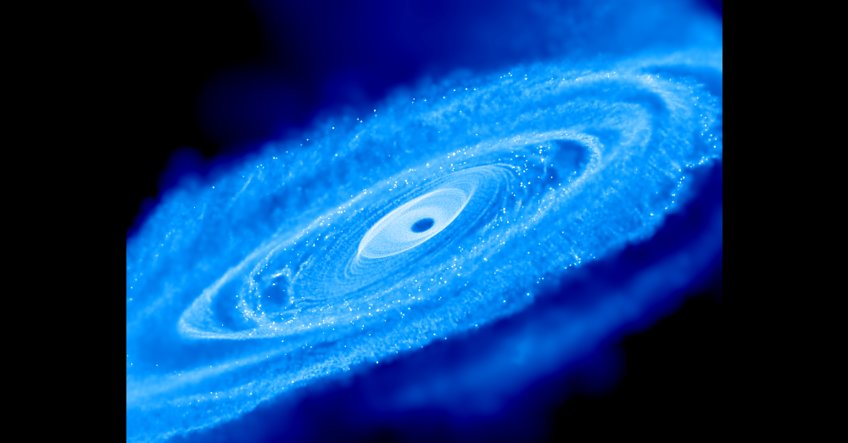
Research
Using numerical simulations, we aim at a deeper theoretical understanding of the origin and evolution of complex stellar and gaseous structures in galactic nuclei as well as their interaction with central black holes. One of our primary focus will be the physics of nearby galactic nuclei that show Seyfert activities, together with the currently inactive Milky Way and Andromeda galaxy as well as the puzzle of the anti-hierarchical black hole growth.
Main topics and goals
Gas and dust structure and nuclear star formation
- origin of the thick turbulent (clumpy) gas tori?
- effects of turbulence in tori: thermal state, geometry, angular momentum transport, fueling of the SMBH?
- turbulence driver: radiative heating and pressure, jets and winds, rotation and shear or star formation?
- star formation in tori: nuclear stellar clusters or rings?
- mass accretion and ejection mechanisms in the nucleus?
- evolutionary sequence including inactive states?
- origin of the anti-hierarchical black hole growth?
The quiescent nucleus of the Milky Way
- why currently inactive? How to trigger active phases?
- origin of the hot bubble, the circumnuclear stellar disks (former torus?) and mini-spiral?
The nucleus of the Andromeda Galaxy
- origin of the outer eccentric old (P1+P2) stellar disks?
- inner young disk (P3) the result of mass loss of stars of the P1+P2 disk?
The G2 cloud
- origin of the cloud
- prediction for future observation
Current Projects
Turbulence in AGN tori
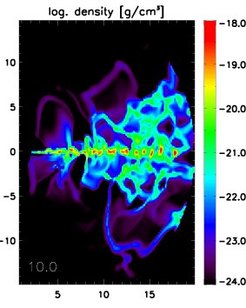
We study the characteristics of turbulence in AGN tori, stirred by discrete energy input mechanisms like supernova explosions or stellar winds and determine the timescales of the decay of the thickness of the resulting density distribution. Below, a cut along a meridional plane is displayed after 10 orbits. This study will show us, whether long term stirring processes are needed.
Marc Schartmann
Star formation in the galactic center
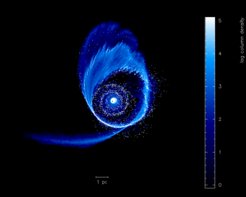
A molecular cloud is put into the potential of a supermassive black hole. We study disruption, disk-phase and fragmentation. Such a scenario might lead to a stellar disk, as seen in our own galactic center. The picture shows the capturing of a cloud of 10^5 solar masses after 0.5 Myrs by a black hole of 10^6 solar masses.
Christian Alig
Stellar wind feedback in Galactic Nuclei, evolution of AGN tori in nearby Seyfert galaxies

We are studying stellar winds for a large range of ambient densities and pressures. Understanding the evolution and interaction of winds, particularly for high pressure external media, will help us in finding a plausible origin for the G2 cloud observed in the Galactic center, as well as in explaining the clumpy and turbulent structure of AGN tori.
Alessandro Ballone
The Formation and Evolution of High-Redshift Galaxies

Young disk galaxies have recently been observed at high cosmological redshifts of z=2, corresponding to epochs where the Universe was just 1/3rd its present age. This epoch is especially interesting as it corresponds to the peak in the star formation rate of the Cosmos and the time when the morphologies of the galaxies were determined. High-redshift galaxies have recently been detected and observed with the larges telescopes e.g. of ESO. It soon became clear that these objects are very different compared with present-day disk galaxies. For example, they form stars with enormous rates that are a factor of 10 - 100 higher than in nowadays. The star formation is concentrated in gigantic clumps of molecular gas, about 1000 times larger than present-day molecular clouds, and as big as dwarf galaxies. In addition, the gas in the disks is highly turbulent, driven by energetic sources that are not well understood up to now. In collaboration with the observational infrared/submillimeter group we are investigating the origin and structure of the observed giant gas clumps in young galactic disks as well as their evolution and star formation history.
Manuel Behrendt
Projects of former Members
GMC formation, spiral structure and formation of star clusters in galaxies
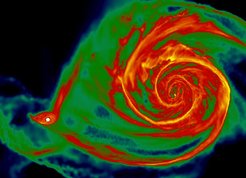
The principal part of my research involves modelling galaxies to understand how giant molecular clouds (GMCs), the sites of star formation in galaxies, form and evolve. The main difficulty with studying star formation in galaxies is the immense range in scales between galaxies and stars. Much of the research in astrophysics concerns the formation of stars in molecular clouds However this misses out the physics of how GMCs form, as governed by large scale processes such as spiral shocks, self gravity and stellar feedback. This is what I work on. I have also done research into spiral structure in galaxies, in particular showing how even detailed features in the famous Whirlpool Galaxy (M51) are reproduced by its interaction with a companion.
Clare Dobbs
Origin of the anti-hierarchical growth of black holes
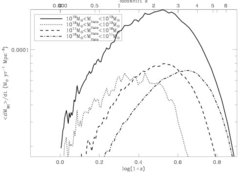
We calculate black hole growth rates, based on merger trees from cosmological dark matter simulations with the GADGET-2 code. These will be confronted with the observed quasar luminosity evolution (quasar downsizing).
Michaela Hirschmann
Radiation driven turbulence in molecular tori
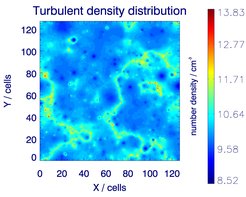
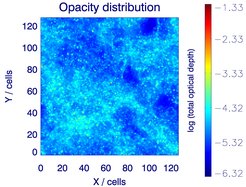
Radiation from AGN might drive turbulence within the torus, which could keep it thick. We aim to perform 3D hydrodynamic simulations with radiative transfer to address this. The example gives an impression how a density slice looks like, and an integration of the total optical depth due to hydrogen and dust extinction at a wavelength just shortward of the Lyman edge.
Martin Krause
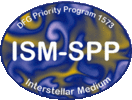 Physics of the Interstellar Medium SPP |  Physics of Galactic Nuclei Group | 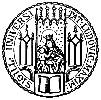 University Observatory Munich |  Excellence Cluster Munich |







